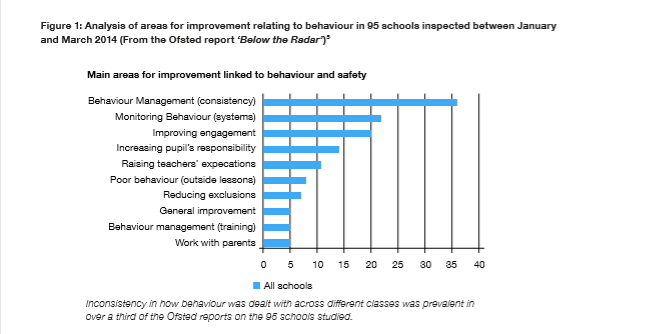There is a wide range of research on the ramifications of poor pupil behaviour and behavioural repair.
Though there may be a common perception that the younger generation is “worse than their predecessors“, due to behaviour repair the opposite is true.
When surveyed, 70-76% of teachers say that behaviour is good or better in their school. How is behavioural repair contributing to this and what can you do to ensure behaviour support in your classroom? Read this quick guide.
What can be done to improve behaviour repair?

Above you will see the areas of improvement for behaviour and safety, according to Ofsted report: below the radar (2014).
Consistency in behaviour management is the leading concern for Ofsted in terms of improving behaviour in the classroom. But what can be done? This blog post explains.
Six recommendations for behaviour repair
The Education Endowment Foundation recommends the following strategies in order to improve classroom behaviour:
- Know and understand your pupils and their influences
- Pupil behaviour has multiple influences, some of which teachers can manage directly
- Understanding a pupil’s context will inform effective responses to misbehaviour
- Every pupil should have a supportive relationship with a member of school staff
2. Teach learning behaviours alongside managing misbehaviour
- Teaching learning behaviours will reduce the need to manage misbehaviour
- Teachers can provide the conditions for learning behaviours to develop by ensuring pupils can access the curriculum, engage with lesson content and participate in their learning
- Teachers should encourage pupils to be self-reflective of their own behaviours
3. Use classroom management strategies to support good classroom behaviour
- Effective classroom management can reduce challenging behaviour, pupil disengagement, bullying and aggression
- Improving classroom management usually involves intensive training with teachers reflecting on their classroom management, trying a new approach and reviewing their progress over time
- Reward systems based on pupils gaining rewards can be effective when part of a broader classroom management strategy
4. Use simple approaches as part of your regular routine
- Some strategies that don’t require complex pedagogical changes have been shown to be promising
- Breakfast clubs, use of specific behaviour-related praise can working with parents can support good behaviour
- School leaders should ensure the school behaviour policy is clear and consistently applied
5. Use targeted approaches to meet the needs of individuals in your school
- Universal behavioural systems are unlikely to meet the needs of all your students
- For pupils with more challenging behaviour, the approach should be adapted to individual needs
- Teachers should be trained in specific strategies if supporting pupils with high behaviour needs
6. Consistency is key
- Consistency and coherence at a whole-school level are paramount
- Whole-school changes usually take longer to embed than individually tailored or single-classroom approaches
- However, behaviour programmes are more likely to have an impact on attainment outcomes if implemented at a whole-school level
Steps for improving behaviour
According to the Ofsted ‘Below the Radar‘ report:
….pupils are potentially losing up to an hour of learning each day in English schools because of this kind of disruptive behaviour in classrooms. This is equivalent to 38 days of teaching lost per year. A large number of pupils, therefore, are being denied a significant amount of valuable learning time.
In this blog post, we talked about the importance of setting standards from the start, rewarding good behaviour and effective classroom management. But there is more you can do.
Behavioural repair: the importance of positive relationships
Teachers usually have positive relationships with students. Research suggests that if the teachers know and understand their students this can have a positive impact on classroom behaviour. In all industries, communication is key. If information is sought and willingly shared by pupils and parents, where behaviour repair is concerned, it can support a coordinated response.
At a teacher level, regularly and internationally focusing small amounts of times working on relationships with individuals can have a big impact.
Praise and motivation
Extrinsic motivation (e.g rewards and praise) is useful to address some minor misbehaviour or to encourage positive behaviour. Teachers can use tangible techniques such as rewards and sanctions, or less tangible strategies such as praise and criticism.
Strategies to improve self-motivation such as these are critical to improving resilience, achieving goals and subsequently success. These pupils are likely to achieve better and are less likely to misbehave.
As a teacher, having a ‘growth mindset’ involves:
- Truly believing that all your students will achieve and improve
- Praise the efforts of a student rather than a person, the end piece of work or results (“You have worked so hard on this” etc)
- Avoid fixed mindset labelling that praises intelligence or talent (“You’re so clever”, “You’re really talented”)
Strategies for classroom management
Training teachers in classroom management practices can improve pupil behaviour in the classroom.
Classroom management tends to be more of a problem for teachers earlier in their careers than those with more experience. Early careers teachers should understand that:
- It is normal for them to have more issues with behaviour management in their classroom than more experienced colleagues. It is ok to ask for help.
- Even the most experienced teachers implementing universal classroom management strategies well will find they do not work for all pupils all the time.
- Some students will need a more tailored approach which may require reflection and adapting to the situation.
- What works for one teacher might not work for another with the same pupil: it may take a while to find the right strategy and it may help to ask a range of colleagues about their approaches.
Reinforcing positive behaviours
Putting in place a clear reward system can improve pupil behaviour in the classroom when used as part of a broader classroom management strategy.
Reward systems mainly involve the presentation of something such as a reward or praise to reinforce desirable behaviours, but can also sometimes involve removing something (such as removing the right to sit next to a friend) as a punishment.
Reward systems can be an effective way to improve pupils’ learning behaviours. Rewards systems are often included in whole-class and whole-school approaches to behaviour – such as star charts or house point systems.
Regular routines
Perfecting your school’s approach to behaviour is likely to require training, external expertise and school-wide coordination – some strategies exist that do not need wholesale changes. When inputting behavioural repair techniques into your school, do not overlook simple things such as:
- Starting the day with a breakfast club
- Greeting each student positively at the door
- Giving specific behavioural-related praise throughout the lesson
- Using simple approaches to improve teacher-student relationships
- Using checklists to ensure behaviour policies and procedures are embedded with rigour
Targeted approach
“A universal approach is unlikely to meet the needs of all students” – so for an intensive support that meet the needs of students a personalised approach is recommended.
These targeted interventions may be implemented by trained teachers; teachers reflecting on their classroom management techniques may be particularly beneficial for the individuals with the greatest needs. For disruptive pupils, targeted interventions are the most effective when adapted to the needs of individuals.
However, a tailored approach to support an individual’s behaviour should complement the school’s behaviour policy without lowering expectations of any pupil’s behaviour.
Other strategies that may be effective for specific individuals behavioural improvement plan may include programmes that encourage physical activity, improve social kills and specific interventions to remove unwanted behaviour.
The key is consistency
While classroom-level strategies have a big impact on pupil behaviour, consistency and coherence are paramount at a whole-school level.
It is helpful to consider the extent to which whole-school approaches to behaviour interventions fit frameworks for whole-school approaches more broadly:
- Are all staff trained, including teaching assistants, receptionists, lunchtime staff, and everyone else who interacts with children?
- Is there a sense of shared responsibility among staff and ideally students too, or is this new policy going to feel ‘done to’ the school community by leadership?
- Are those in the wider school community (beyond the SLT and teachers) involved?
- What impact will you see in school if this strategy is successful? How do you plan to measure this?
- When would you expect to see an impact? Is it feasible for this approach to be left until then, or will changes be made that will blur the outcome? If so, is now the right time to implement the strategy?
Zero tolerance
Zero tolerance behaviour policies, sometimes described as “no excuses”, aim to create a strict and clear whole-school approach to discipline. Typically, under such policies, pupils will automatically receive detentions for a range of misbehaviours such as being late, forgetting homework or using rude language. Other more serious conduct – such as bringing a weapon to school – may result in exclusion, without exception.
Conclusion
When deciding which behaviour approaches to adopt as part of your school’s behaviour strategy, it may be helpful to consider combining two intervention approaches which are supported by evidence:
- Tailor approaches to individual pupils, focus on improving relationships, and include intensive teacher training (over 20 hours) and
- Focus on academic issues, teaching coping and resilience skills
Tailoring approaches to individuals and focusing on building relationships can be effective, but this needs to occur with an appropriate amount of teacher training. An alternative is to focus on academic issues and teaching learning behaviours, but not focus on relationships. This might be interpreted as a response to behaviour that is more focused on individual student responsibility for behaviour and academic goals.
How can EDClass help with behavioural repair?
EDClass can help with behavioural repair in a number of ways.
A targeted learning pathway provides individualised learning in order to help students undertake lessons most suitable to their needs.
A comprehensive reporting tool highlights progress made within our e-learning portfolio, available to senior leaders, teachers, assistants and parents, to show the improvements of behaviour.
In working with Rodillian Academy in 2013, we developed a unique package to support students who are out of mainstream education – providing them with appropriate, accessible work that is accessed through a secure online.
We expect students who are expelled from school to complete a set number of hours via EDClass: staff from school and parents/carers can monitor their activity online. The response from parents/carers has been overwhelmingly positive as it mean they can measure the quality of work that students have completed whilst not in school.
As part of the personalised programme for students who are expelled from school for a fixed period of time, they must complete a programme of behaviour repair work which is then discussed at the reintegration meeting. Over 95% of students who have been expelled from school have completed the required behaviour repair work and the required amount of hours to a satisfactory standard.
For more information on how EDClass can help with behavioural repair, call 01909 568 338.










